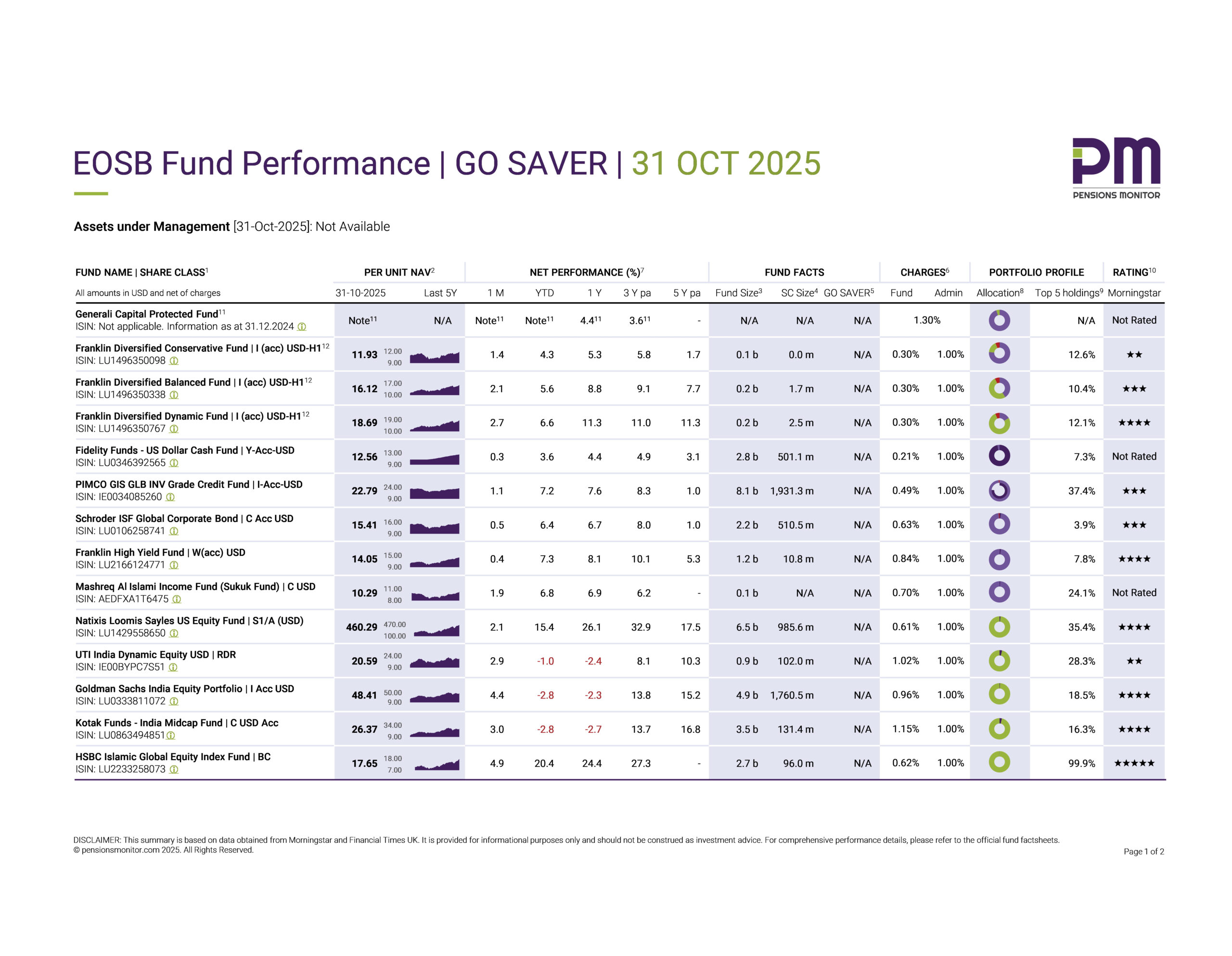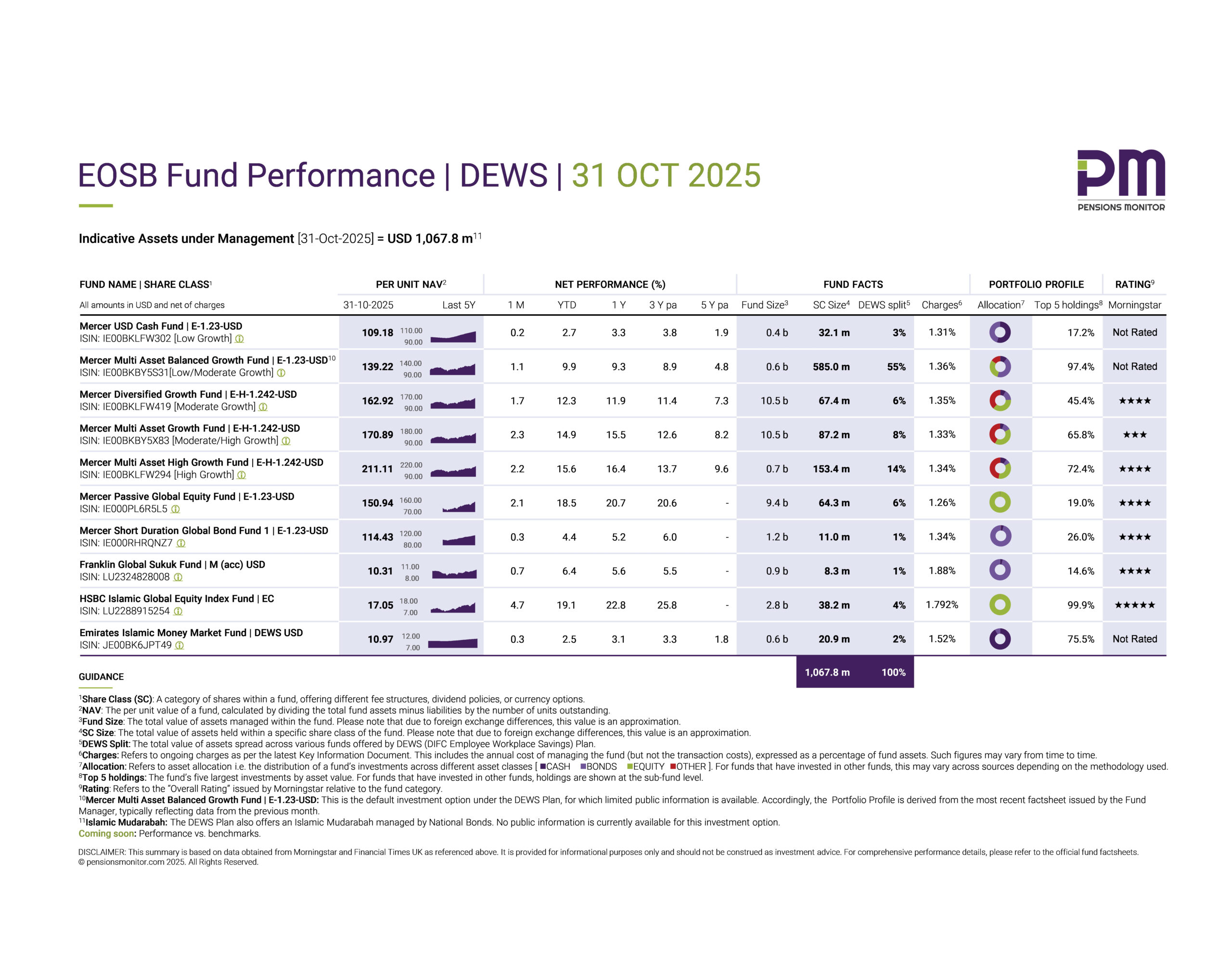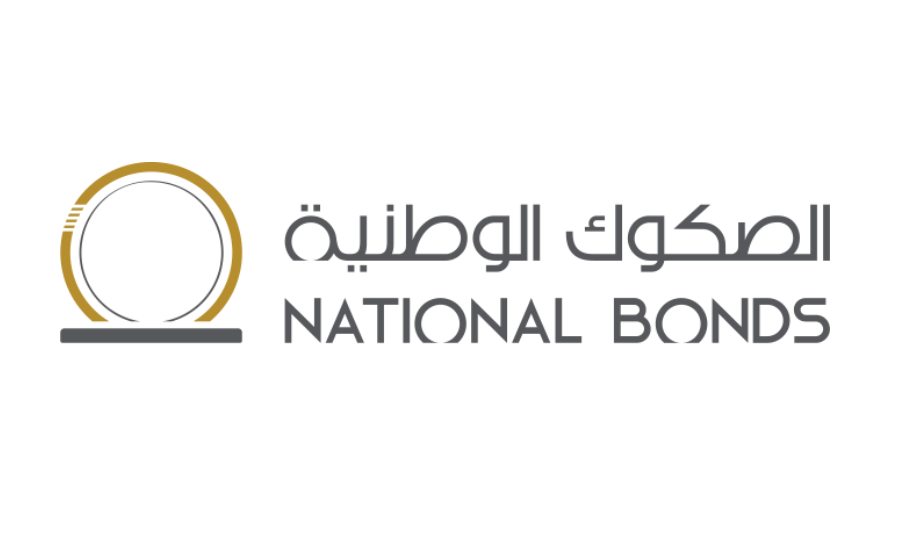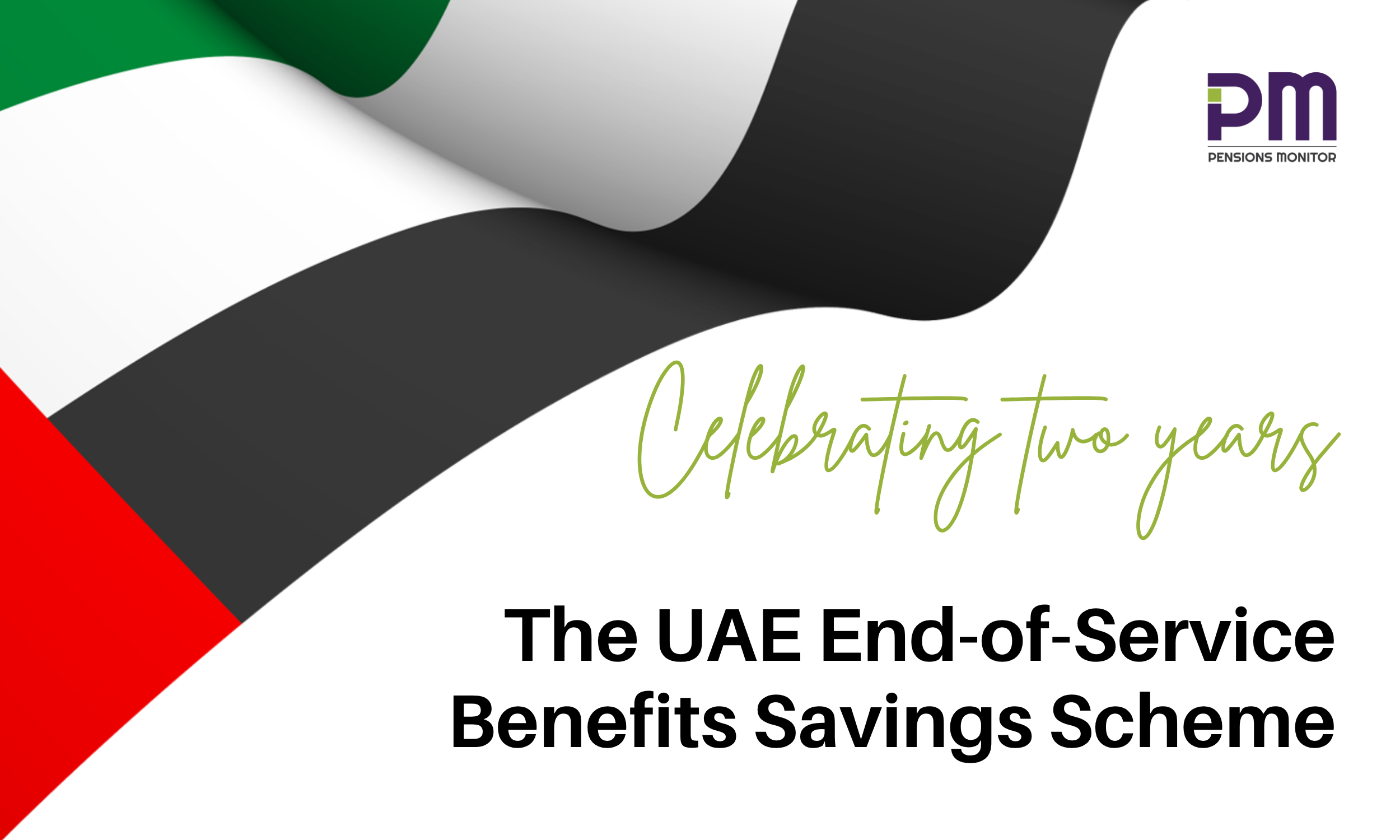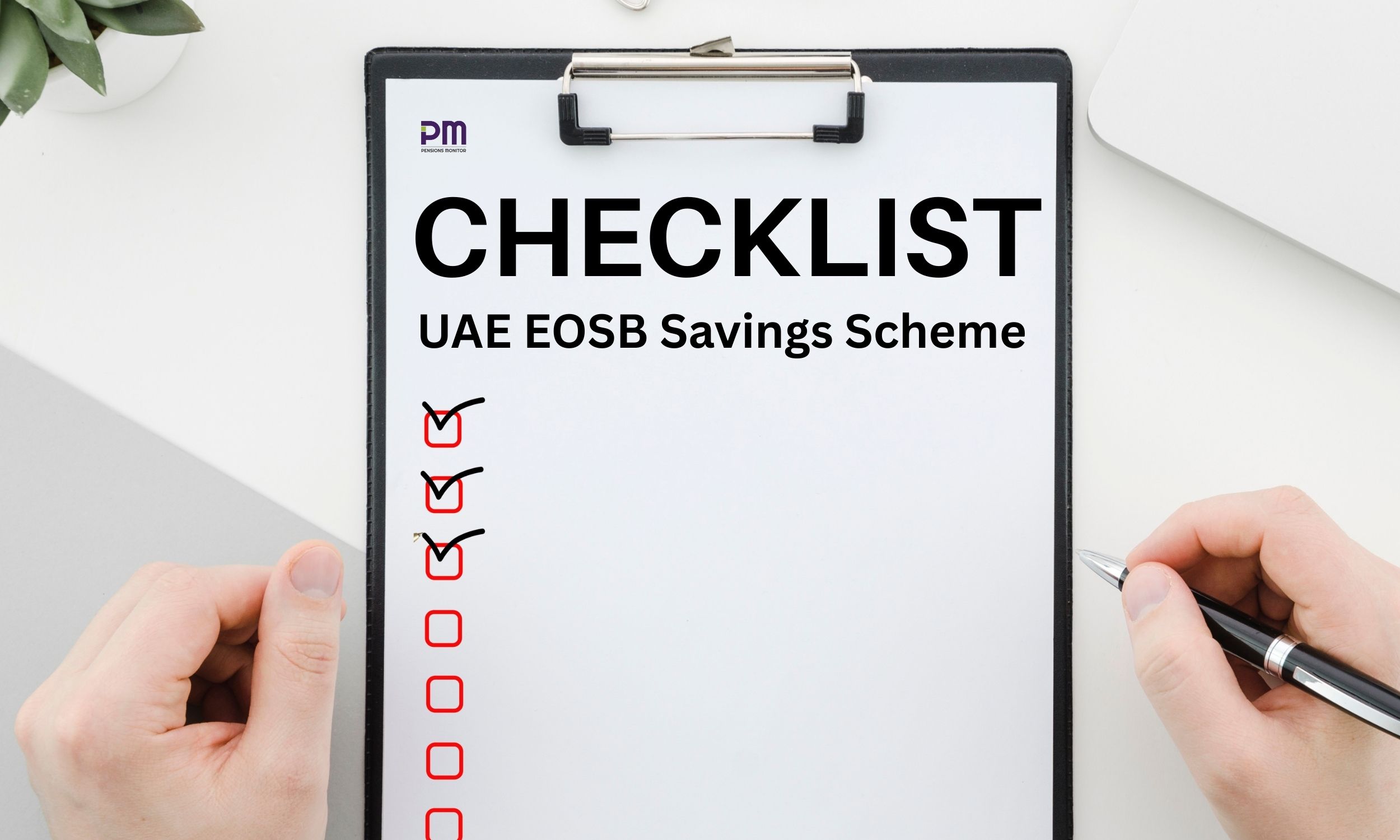
Ever since Cabinet Resolution 96 of 2023 introduced the new Alternative End-of-Service Benefits (EOSB) Savings Scheme in October 2023, interest in workplace savings schemes has grown significantly in the United Arab Emirates (UAE). While a few companies are evaluating their options internally, the majority rely on advisors and consultants for guidance. In doing so, companies are often introduced to other solutions, such as pension plans or voluntary workplace savings schemes marketed as end-of-service savings plans.
Why does this matter?
Because these other solutions do not serve the same purpose as the UAE EOSB Savings Scheme which is primarily to protect employee end-of-service dues and at the same time, reduce EOSB liabilities for companies. And with expectations that the scheme may become mandatory in the future, it is even more important for companies to understand the differences and select the correct solution.
This article is your all-in-one guide, that explains how the UAE EOSB Savings Scheme differs from other voluntary financial products and also includes a practical checklist to help ensure you are offered the right solution, and not an unrelated savings or pension plan.
Let’s start with some context.
Why the UAE EOSB Savings Scheme was introduced?
First: To safeguard employee dues
The UAE EOSB Savings Scheme was introduced by the Ministry of Human Resources and Emiratisation (MOHRE) to ensure that employees’ end-of-service dues are fully secured. The new system provides a more structured, transparent, and investment-driven approach, ensuring employees benefit from improved security and long-term financial planning.
To address this risk of employer default, the UAE EOSB Savings Scheme establishes a structured savings system, similar to those used in many countries, whereby:
- Companies transfer contributions every month to approved service providers/Fund Managers;
- Employees choose how to allocate the contributions to investment funds offered by the Fund Manager; and
- The invested contributions may generate returns over time, potentially resulting in a higher eventual payout.
With this new system, employees in the UAE have control over company money that is legally due to them unlike the gratuity system which only represents a future promise.
Second: To provide access to a regulated investment platform
Through this structured savings scheme, the UAE has also enabled access to a regulated, low-cost investment platform for every single employed resident in the country who desires to voluntarily invest a portion of their salary (separate from the employer’s mandatory payments) towards savings. Previously, retail investment options in the UAE were limited to banks, life-cum-savings insurance products, or third-party investment platforms which carry relatively higher charges and fees. With the new scheme, employees have a transparent and regulated platform to grow their EOSB savings.
Third: To offer security and long-term planning
Many people in the UAE (especially those with long-term visas like Golden Visas or retirement visas) want to stay and build their future in the UAE, but often don’t have enough savings set aside.
The new EOSB Savings Scheme helps by making sure their end-of-service money is paid, protected, and invested every month, so they can plan for the long-term in the UAE instead of waiting for a lump-sum gratuity when they leave a job, which isn’t guaranteed.
What’s in it for employers?
There are great incentives for companies as well.
First: Reduce EOSB liability by replacing the gratuity system
When companies enroll their employees in the scheme, the gratuity system is officially replaced. And every monthly contribution paid, effectively fulfils the employer’s legal obligation towards end-of-service dues and reduces EOSB liability. Simply put, it’s “pay-as-you-go” for companies.
Second: Predictable lower costs and cash outflows
Compared with the gratuity system:
- Costs are predictable month-to-month based on current salaries, resulting in a lower spend over a period of time compared to the gratuity system (which is calculated on the final basic salary).
- Cash outflows are also predictable and employers can avoid large, lump-sum payouts especially when multiple employees leave simultaneously.
Third: Employee retention tool
The scheme can also be a great way to entice employees to stay longer with the company by offering additional employer contributions above the legal minimum, tied to vesting schedules over a period of time, say 3 to 10 years.
How is the scheme structured?
The scheme has been designed with strong regulatory safeguards in place.
- The approved “service providers/fund managers” have been carefully vetted by MOHRE and the Securities and Commodities Authority (SCA) who is the regulator of the capital markets in the UAE. This ensures that employers and employees have a local regulator to fall back on if there’s a dispute. This is not the case when participating in unofficial offshore plans.
- Each approved Fund Manager must appoint a custodian responsible to safeguard the assets. This is a great protection mechanism if there’s a financial failure by any employer or service provider/fund manager. As per SCA website, there are six SCA-approved custodians in the UAE, all of which are leading banks.
- All funds under the UAE EOSB Savings Scheme are domiciled in the UAE with clear investment guidelines overseen by SCA.
- Each approved Fund Manager has to offer a Capital Guarantee/Protection Fund as a minimum, and may also offer risk-based funds, to suit the financial risk appetites of the diverse workforce in the UAE.
- Once enrolled in the scheme, employees who have completed 1 year with their company can choose which funds their mandatory employer contributions are invested in.
- EOSB Savings in the scheme can only be withdrawn upon employee resignation, retirement, or death, with company clearance.
This ensures employee end-of-service dues are funded on a monthly basis and fully ring-fenced, in contrast to the gratuity system. It also gives employees control to plan their future end-of service payout from the time of enrolment. This is something that neither the current gratuity system nor any unofficial scheme can offer employees in the UAE.
How secure are the savings?
The EOSB Funds Scheme has been built with several layers of protection to keep employee savings secure. Employees can choose from a range of investment funds with different risk levels: from capital guaranteed/protected options, conservative fixed income options, balanced and growth-oriented portfolios. But as with any investment, returns are not guaranteed and are subject to market risk.
However, since contributions are made every month, employees benefit from a principle known as dollar-cost averaging. This simply means contributing a fixed amount regularly, regardless of whether markets are high or low. Over a typical employment horizon of 5–7 years, this approach helps smooth out market ups and downs, reducing the impact of volatility and supporting more stable long-term growth.
Is the scheme going to become mandatory in the future?
There is no official confirmation yet on whether the EOSB Savings Scheme will become mandatory. However, considering the national-level purpose behind the reform i.e., protecting employee dues, formalising end-of-service funding, and strengthening long-term financial security, many expect that the scheme could eventually move in that direction.
Significant regulatory effort has already gone into designing, approving, and launching the framework, which naturally suggests that wider adoption is part of the long-term vision. If the scheme does become compulsory, every company in the UAE will need to enroll their staff under the new system.
With this possibility on the horizon, any company exploring workplace savings options should proceed carefully. If you are taking advice from an advisor or consultant, use this checklist to ensure you’re being guided toward the correct solution (the UAE EOSB Savings Scheme) and not an unrelated savings or pension product.
Checklist: 10 Questions to avoid being mis-sold
Use these questions when consulting an advisor or broker:
1. Is it regulated under UAE Labour Law?
- EOSB Savings Scheme: Yes, it is part of the UAE Labour Law.
- Savings/Pension Plans: No, these are financial products, not linked to the labour law but are often structured to deliver at least the mandatory gratuity as a minimum.
If the product does not reference the UAE Labour Law, it’s the wrong solution for the purpose of EOSB.
2. Does the scheme officially replace gratuity?
- EOSB Savings Scheme: Yes, it legally replaces the end-of-service gratuity structure.
- Savings/Pension Plans: No, gratuity must still be paid in the old way as employer obligations under the UAE Labour Law remain unchanged.
If the advisor cannot clearly explain how gratuity liability is reduced or removed, stop here.
3. Who is expected to contribute?
- EOSB Savings Scheme: Employer only. These contributions belong to employees as soon as the employer deposits them.
- Savings/Pension Plans: Typically, employers contribute as a perk, part of which may be tied to mandatory employee contributions and linked to vesting schedules.
If your employees need to use their own salary, this is not the EOSB Savings Scheme.
4. Who can choose the funds where the mandatory employer contributions are invested?
- EOSB Savings Scheme: Employees can choose how to invest the mandatory employer contributions, except those earning less than AED 4,000 per month. Employees earning below this threshold are restricted to the Capital Guarantee/Protection Fund, designed to protect low-income workers from investment risk.
- Savings/Pension Plans: Employees usually do not have discretion over how the employer’s contributions are invested, because an inappropriate fund selection by employees could increase the employer’s EOSB gratuity liability.
If employees cannot choose the investment funds and plan how to grow their EOSB savings, it is not the UAE EOSB Savings Scheme.
5. Who can control/withdraw the savings (mandatory employer contributions + investment returns)?
- EOSB Savings Scheme: Employees who completed 1 year with their company only. Employers cannot reclaim the money and the savings are paid directly from the scheme to the employee’s bank account on resignation, retirement or death.
- Savings/Pension Plans: Employers have control over the savings, because these are employer-sponsored and employer-controlled plans. Employers set the rules of the plan, and the plan providers must act according to the plan rules written by the employer when the plan is created. Payouts are based strictly on employer instruction, and could even flow back to the employer who in turns pays the employee.
If the employer controls the mandatory employer contributions, or if the savings flow back to the employer first, employees remain exposed if the employer is in financial distress. This is not the case with the UAE EOSB Savings Scheme.
6. Are the fees transparent and institutional?
- EOSB Savings Scheme: Yes. No commission, performance, subscription or redemption fees.
- Savings/Pension Plans: Often high and opaque fees. Some products carry a hefty distribution commission to incentivize sales agents.
If the fee schedule is overly complicated or not transparent, walk away.
7. Is it free to switch funds?
- EOSB Savings Scheme: Yes. No switching charges.
- Savings/Pension Plans: Switching charges may apply.
If switching costs money, it’s likely a pension wrapper, not EOSB.
8. Does it reduce your EOSB liability?
- EOSB Savings Scheme: Yes, this is an important difference. The official scheme turns gratuity into a funded, predictable monthly contribution. With monthly contributions paid, employers have no further EOSB obligations, apart from the gratuity accumulated till the date of transition to the scheme, if this amount was not also transferred to the scheme.
- Savings/Pension Plans: No, gratuity liability keeps accumulating and remains on the balance sheet.
If your liability isn’t reduced or removed, the product is not fit for purpose.
9. Does the onboarding process look like a corporate process, or a retail product?
- EOSB Savings Scheme: Yes, designed for mass onboarding through employer and payroll integration. Employees may sign simple acknowledgements during transition, but they should not be opening individual investment accounts or providing individual documentation.
- Savings/Pensions Plans: Many offer bulk onboarding and payroll integration as well, but some require employees to complete detailed personal forms, risk profiles, or individual investment account paperwork.
If the onboarding requires each employee to complete lengthy personal forms, that’s not the EOSB Savings Scheme. Remember, the EOSB Savings Scheme is part of the UAE Labour Law and will not require employee KYC when onboarding.
10. Is the provider an SCA-licensed Fund Manager?
- EOSB Savings Scheme: Offered by Fund Managers approved by MOHRE and licensed by SCA.
- Savings/Pension Plans: Often sold by brokers who are remunerated by sales commissions.
If the person selling the product earns commission, you risk mis-selling. Always check the official listing of the approved EOSB Fund Managers on the MOHRE website or contact the call center 600 590000 for further information.
Takeaway
As workplace savings solutions gain traction in the UAE, it’s easy for companies to be presented with products that look similar on the surface but are not part of the official UAE EOSB Savings Scheme.
While some of these alternative solutions may offer attractive fund choices, performance, or even lower fees, they do not remove employer obligations under the UAE Labour Law or provide the same employee safeguards that are built into the official scheme, for all the reasons outlined above.
Furthermore, once the UAE EOSB Savings Scheme becomes mandatory, there is no guarantee that exemptions will be granted to employers using unofficial arrangements.
So before choosing any solution, use the checklist above to verify that what you’re being offered is genuinely aligned with UAE Labour Law. Always confirm that the service providers and fund managers are officially listed on the MOHRE website.
Getting it right from the start will spare your company from avoidable cost, confusion, and compliance issues later.
We hope you found this article useful. Sign up for our free newsletter to receive regular updates on EOSB developments in the UAE.

